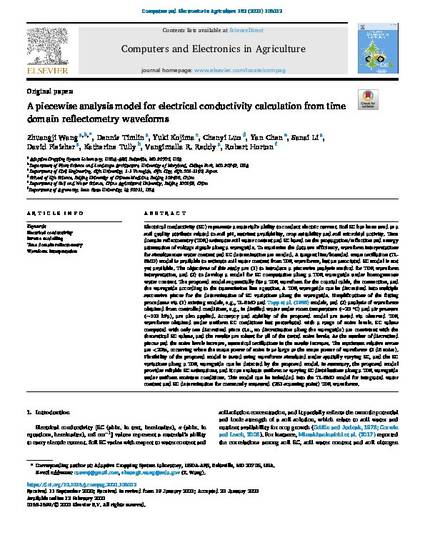
Electrical conductivity (EC) represents a material’s ability to conduct electric current. Soil EC has been used as a soil quality attribute related to soil pH, nutrient availability, crop suitability and soil microbial activity. Time domain reflectometry (TDR) estimates soil water content and EC based on the propagation/reflection and energy attenuation of voltage signals along a waveguide. To maximize the data use efficiency, waveform interpretations for simultaneous water content and EC determination are needed. A tangent line/bounded mean oscillation (TL-BMO) model is available to estimate soil water content from TDR waveforms, but an associated EC model is not yet available. The objectives of this study are (1) to introduce a piecewise analysis method for TDR waveform interpretation, and (2) to develop a model for EC computation along a TDR waveguide under homogeneous water content. The proposed model sequentially fits a TDR waveform for the coaxial cable, the connection, and the waveguide according to the transmission line equation. A TDR waveguide can be discretized into multiple successive pieces for the determination of EC variations along the waveguide. Simplifications of the fitting procedures via (1) existing models, e.g., TL-BMO and Topp et al. (1988) models, and (2) analysis of waveforms obtained from controlled conditions, e.g., in distilled water under room temperature (~20 °C) and air pressure (~101 kPa), are also applied. Accuracy and stability of the proposed model are tested via observed TDR waveforms obtained under uniform EC conditions but perturbated with a range of noise levels. EC values computed with only one discretized piece (i.e., no discretization along the waveguide) are consistent with the theoretical EC values, and the results are robust for all of the tested noise levels. As the number of discretized pieces and the noise levels increase, numerical oscillations in the results increase. The maximum relative errors are <20%, occurring when the mean power of noise is as large as the mean power of waveforms (0 dB noise). Flexibility of the proposed model is tested using waveforms simulated under spatially varying EC, and the EC variations along a TDR waveguide can be detected by the proposed model. In summary, the proposed model provides reliable EC estimations, and it can evaluate uniform or varying EC distributions along a TDR waveguide under uniform moisture conditions. This model can be imbedded into the TL-BMO model for integrated water content and EC determination for commonly measured (251-scanning point) TDR waveforms.
Available at: http://works.bepress.com/robert-horton/148/

This article is published as Wang, Zhuangji, Dennis Timlin, Yuki Kojima, Chenyi Luo, Yan Chen, Sanai Li, David Fleisher, Katherine Tully, Vangimalla R. Reddy, and Robert Horton. "A piecewise analysis model for electrical conductivity calculation from time domain reflectometry waveforms." Computers and Electronics in Agriculture 182 (2021): 106012. doi: 10.1016/j.compag.2021.106012.